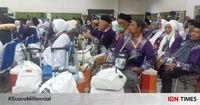Pamekasan, Indonesia - In a significant development regarding the upcoming Hajj pilgrimage, the Pamekasan Regional House of Representatives (DPRD) has raised concerns for 437 high-risk prospective pilgrims (CJH) out of a total of 1,049 from the region. This issue was brought to light by Halili Yasin, Chairman of Commission IV of the DPRD, during a statement made on Thursday, May 1, 2025. Yasin emphasized that the high-risk designation for these pilgrims is an unavoidable reality due to various factors, including long waiting periods and the economic capabilities of the community.
Yasin stated, "The high-risk category for CJH in Pamekasan is unavoidable. However, it is the responsibility of the Ministry of Religion (Kemenag) Pamekasan to ensure that the pilgrimage process is safe from preparation to return home." His comments reflect a growing concern among local officials regarding the health and safety of pilgrims.
The DPRD is urging relevant agencies to ensure readiness across all aspects of the pilgrimage, including the availability of medical personnel, participant health monitoring, and the provision of essential medicines during the Hajj process. Yasin added, "We hope that all CJH from this area can complete their pilgrimage safely and without any issues. It is crucial that medical personnel are prepared to provide timely assistance to prevent any fatal outcomes."
In response to these concerns, Abdul Halim, Head of the Hajj and Umrah Section of the Pamekasan Ministry of Religion, confirmed that they have completed data collection on both CJH and medical personnel. He assured that all parties are prepared for the upcoming pilgrimage. Furthermore, Halim noted that local CJH are covered under the National Health Insurance (JKN) program, which is administered by the Pamekasan Social Security Administering Body (BPJS) Kesehatan.
"We are 100 percent confident that the CJH will have a smooth pilgrimage experience," Halim stated. This assurance is bolstered by the fact that the BPJS Kesehatan will cover any medical treatment costs if pilgrims fall ill before their departure. Additionally, upon their return, any necessary medical care will also be provided according to applicable regulations.
Moreover, Halim explained that as JKN participants, CJH can access required medications before departing for the Holy Land. "When they arrive at the Hajj dormitory, each pilgrim's health will be checked again before their flight. We believe everything will go smoothly," he concluded.
Meanwhile, in Lombok, the Health Team for Hajj Embarkation revealed that a staggering 91.54 percent of the Jemaah Calon Haji (JCH) in the first cluster from West Lombok are categorized as high-risk. On May 1, 2025, 384 JCH from West Lombok arrived at the NTB Hajj Dormitory, which includes 209 men and 175 women.
Suparlan, a representative from the Health Team for Hajj Embarkation at Balai Kekarantinaan Kesehatan Mataram, reported that out of 390 pilgrims examined, 91.54 percent were found to be in the high-risk category. He specified that there are 140 JCH aged over 60 years classified as severely high-risk, while 211 JCH under 60 years are considered to be at moderate risk. Additionally, 6 JCH over 60 years old were declared healthy, and 33 individuals fall under the general high-risk category.
Despite the high-risk classifications, all JCH in cluster 1 have been declared fit to fly. Suparlan noted that 24 JCH from this cluster visited the NTB Hajj Dormitory Polyclinic, but none were referred to a hospital for further treatment. "Alhamdulillah, as of 5:30 PM WITA, all pilgrims have been deemed fit to fly," he stated.
The JCH from cluster 1 is scheduled to depart for the Holy Land on Friday, May 2, 2025, at 01:50 WITA via Lombok International Airport (LOP) to Medina (MED). They will be flying with Garuda Indonesia on flight number GIA5101, using a Boeing 777-300ER aircraft.
In total, 4,499 JCH from NTB will participate in the pilgrimage this year, divided into 12 clusters. The departure of these pilgrims is set to take place from May 2 to May 17, 2025. This year's preparations highlight the importance of health and safety, particularly for those classified as high-risk, ensuring that all necessary precautions are in place for a successful pilgrimage.
The focus on health and safety for high-risk pilgrims underscores a broader commitment to the welfare of all participants in the Hajj, reflecting the ongoing efforts by local governments and health authorities to provide necessary support and resources.




